Here is a list of what we have found to be the best floor paint. Doing a basement floor (or garage)? That is a slightly different animal as in this article on basement floor paint.
Read more on how to paint plywood in particular. Concrete? Read our in-depth article about concrete paint.
First, the best floor paint recommendations and then a complete list all you need to know about how to paint a floor. Fairly easy.
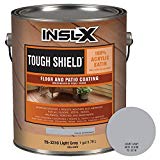 My#1 choice for best floor paint today is Benjamin Moore’s Tough Shield, a very tough coating: Ben Moore’s best floor paint period. The coverage is high and the price is not much higher than the competition: plus it’s better…hello? I recommend this to my customers because it lasts.
My#1 choice for best floor paint today is Benjamin Moore’s Tough Shield, a very tough coating: Ben Moore’s best floor paint period. The coverage is high and the price is not much higher than the competition: plus it’s better…hello? I recommend this to my customers because it lasts.
Easy work for a painter, and savings for you
I always looked forward to painting a floor: no dropcloths, no ladders, and fast! (Just as long as I had my knee pads).
I won’t make any jokes about getting painted into a corner. I’m not trying to be funny. If I was trying to be funny I’d say did you hear about the beer just for painters? They put the label on the bottom that says: “Open Other End.”
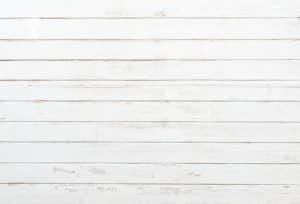 We get asked: “Can you paint laminate floors or paint vinyl floors?” Salespeople will tell you yes. We say a big no*. Yes, you can sand, use chemical etching and expensive primers and try to make the best floor paint bond to these materials, but you are really setting yourself for a big mess that’s worse when you must re-do later. This kind of flooring is not made to be painted and the job will not last very long. Just pull up the laminated floor and put in something that you never worry about.
We get asked: “Can you paint laminate floors or paint vinyl floors?” Salespeople will tell you yes. We say a big no*. Yes, you can sand, use chemical etching and expensive primers and try to make the best floor paint bond to these materials, but you are really setting yourself for a big mess that’s worse when you must re-do later. This kind of flooring is not made to be painted and the job will not last very long. Just pull up the laminated floor and put in something that you never worry about.
Can you paint ceramic tile? No, but some will say yes, and they will say “buy my stuff”. Don’t do it. Tiles were never made to be painted! Same as the paragraph above!
Tips:
- Buy the best floor paint you can afford to prevent future headaches! Floors get abused. Why repaint after only a handful of years? Many photos you will see around the internet are taken right after the floor was painted so of course, it looks great. How about 5 years later? Use the best floor paint—save time and money.
- Plan on a lot of free time later: floor painting goes very quickly. Other than moving furniture, most house floors take about an hour to actually paint. Plan carefully and copy all the steps that relate to your situation from the checklist below.
1. One coat is ok for previously painted floors (with the best floor paint)
Here are 3 good choices (#3 is best)
KILZ Interior/Exterior Enamel Porch & Patio Latex Floor Paint
This floor paint has great reviews.
- Very reasonable cost
- Only 2 colors to choose from—a gray and another gray—but we all like gray, right?
- Low-luster (typical for floors)
- Not for garage floors, not for concrete
- Interior/Exterior
Water-based, one gallon covers 200-300 sq. ft. This is less than wall paint because floors have more texture, little peaks and valleys take paint.
Another option is from a very old company: Valspar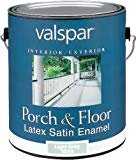
-
- A very good choice that can be used indoors or out
- 3 color options, including white which is hard to find in a floor paints (white, light gray and dark gray)
- Water-based
- Not for garage floors
- Fine for concrete, wood, and primed metal
Coverage for a gallon is not specified: we were told in a support email: “400 sq. ft. depending on surface porosity. When 2 coats are needed for new concrete or badly worn areas, thin the first coat w/1 pint water per gallon paint, and apply 2nd coat un-thinned”.
Benjamin Moore’s INSL-X Tough Shield Acrylic Floor/Patio Coating 
-
- Made by Benjamin Moore and professionals use a lot of it
- Not expensive for the quality, and shipping is free, so just sayin’
- 5 colors, lacking a white
- Not for garage floors, but ok for concrete, wood, (and metal if you use a metal primer)
- Interior or exterior, water-based
- Great coverage per gallon: 350-450 sq. ft.
- This is Ben Moore’s best floor paint
HonorableMention is Benjamin Moore’s INSL-X Sure Step (comes in 6 colors)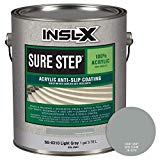
Tested in extreme conditions as are all Ben Moore paints: this is also one of the best floor paint for the money, no doubt.
- Comes in six colors including white: believe it or not, white is hard to find in a quality floor paint
- Interior or exterior, and water-based
- Wood, concrete, or metal floors
- Anit-slip but you can still add sand (silica) – toss it on the wet floor and roll over it, don’t mix in the solution!
- It goes on quite thick: it only covers about 100 square feet, but that is a big plus
- Not for garages
2. Floor paint and prep: “how-to”
First the prep
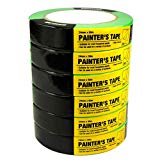 Think it through. Plan how you will move furniture back and forth in 2 phases of painting if you cannot move it out. You’ll get paint on things, so think about covering nice things with plastic drop cloths. To hold the plastic in place and for edges, use green painter’s tape: the old fashioned tan masking tap leaves a glue mark after a few hours. Have soft old blankets or cloth (even cardboard) standing by (to protect the newly painted floor).
Think it through. Plan how you will move furniture back and forth in 2 phases of painting if you cannot move it out. You’ll get paint on things, so think about covering nice things with plastic drop cloths. To hold the plastic in place and for edges, use green painter’s tape: the old fashioned tan masking tap leaves a glue mark after a few hours. Have soft old blankets or cloth (even cardboard) standing by (to protect the newly painted floor).- Under your furniture, place old blankets/cloths you will need when you move it to the freshly painted section for phase 2. This will keep the furniture from scratching, or sticking and pulling off the new soft floor paint. You may have to clean in sections, them move, then paint in sections, or be willing to do half to completion, then the rest. Remember that paint takes months to cure to final hardness.
- Here you can grab any of the prep tools you don’t yet have. Make a list based on our list. Think scrapers, wire brushes, work light… We have lots of info on easy cleanup on this site. Start with how to clean rollers.
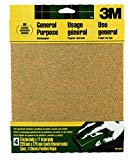 What you see is what you get: the final product how smooth or rough the floor looks when your prep is done. Feather the edges of old paint that won’t scrape off, and sand and clean well any wooden floors to create a paintable surface. This pack of sandpaper has a variety of grits (start with coarse and finish with the medium).
What you see is what you get: the final product how smooth or rough the floor looks when your prep is done. Feather the edges of old paint that won’t scrape off, and sand and clean well any wooden floors to create a paintable surface. This pack of sandpaper has a variety of grits (start with coarse and finish with the medium).- Un-even floor in spots? A floor leveler is easy to use. DAP is trustworthy: Here is a concrete patch and here is a floor leveler other floor types. First, measure the area for what you need and check the details so you don’t buy too little. If your floor leveler calls for a primer, prime it when you do the rest. I know that you probably knew that.
- Caulk/fill cracks after cleaning and priming. Large gaps should be filled with a special floor crack injection. A good option caulk tubes of cement caulk. Read all about how to caulk and caulk guns. Crack fillers may need to be primed (check the product you buy), but caulk generally does not need to be primed.
- First, clean the area you will do LAST. When you clean anywhere, you will spread dust so only clean one time, in two stages. Clean your holding area first, then move furniture onto that section, then cover it all with plastic/cloth as above, and protect the floor you cleaned from dust. Then clean the other section that you will paint first.
- Clean in this order: vacuum then mop, then on your hands and knees use a damp cloth in corners. You want to get 99% because everything you leave on the floor will make it’s way to the paint bucket and get spread around. This will lead to paint chipping in time. This is the hardest part: it gets better.
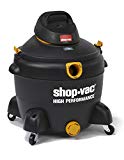
- Concrete floors that were never treated probably do not have to be acid etched first. If the builder trowled it very smooth, then yes, you need to create a ‘profile’ or roughness like the feel of about medium (80 grit) sandpaper. Acid washing does this. My advisor at one big paint company prefers floor sanding to acid, but both create the surface you can paint. Muriatic acid is the lowest cost way to do this and if you are comfortable with using a mild acid, go ahead. We prefer Rust-Oleum eco-friendly concrete etcher which is not harmful to plants or healthy skin. Rinse either solution 3 times and suck up with your wet/dry Shop-Vac or towels. If you have a drain, and it works, that’s best. Work the etching solution with a brush or a broom. If you decide on real acid, please always add acid to water—never add the water to the acid which prevents any acid splashes. Heat is generated and can propel it out at you. (Wear full protective gear for eyes, skin, etc). Rinse 2-3 times and let dry fully. See California warning on muriatic acid below*.
- If needed after it’s dry, use concrete crack filler discussed above.
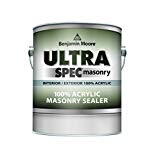
- Primers: Some concrete floors are very alkaline (especially new ones). Special masonry primers allow you to use any floor paint because by creating a bond to the alkaline concrete, where the paint will not. (Remember, always wait at least a month for new concrete to cure). Ultra-spec is the contractor line of paint from Benjamin Moore, and this masonry sealer is intended for garage and concrete floor priming. You can our detailed article about concrete floor paint and planning.
-
How to paint the floor: Karate Kid wax on
Ready? Go. Wait. Safety first. Wear a respirator if you will be using any toxic materials. Here I explain how to keep it simple.
-
-
- Any of the paints listed above are a good choice: we always say get the best you can afford as it really saves money in the long run. These will usually only need one coat, but read your paint’s label. Now, to paint a floor is the easy part…
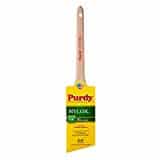 Cut the edges. Go all around the edges first. A quality brush will find the corners at least as good as taping, but some people do prefer the tape. For walls and ceilings, we tell people to ALWAYS roll before you brush (cut), but when painting a floor, you cannot do that. Work this fact into your exit plan. Doing epoxy or oil-based? Use a good brush, but not so expensive that you’ll hate tossing it, which you will. Another decent choice is the Wooster 4-inch. Don’t go with the dollar store thing. The bristles fall into your paint and you won’t like picking them out. Same for the roller cover below: did you ever see lint in the paint on the wall? No thanks. Get one for life by spending a few dollars more, Clint. Here is the easy & quick way to clean a quality brush.
Cut the edges. Go all around the edges first. A quality brush will find the corners at least as good as taping, but some people do prefer the tape. For walls and ceilings, we tell people to ALWAYS roll before you brush (cut), but when painting a floor, you cannot do that. Work this fact into your exit plan. Doing epoxy or oil-based? Use a good brush, but not so expensive that you’ll hate tossing it, which you will. Another decent choice is the Wooster 4-inch. Don’t go with the dollar store thing. The bristles fall into your paint and you won’t like picking them out. Same for the roller cover below: did you ever see lint in the paint on the wall? No thanks. Get one for life by spending a few dollars more, Clint. Here is the easy & quick way to clean a quality brush.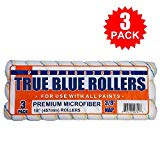 Roll. I once wrote: “roller pans are for rookies, so use a bucket”. But for floor painting, we don’t even use a bucket! We just pour a cup or two of paint on the floor in a puddle! We use an adjustable pole which saves your back work. This pole works with broom screw rollers and quick-lock. The roller cover you use is important: budget roller covers shed lint and will totally ruin your work. This shows how trying to save money is very expensive! Most floor paints call for a 3/8-inch roller nap, but do check your paint’s label. When brushing and rolling, don’t leave puddles, but do coat it liberally. Cleaning roller covers is easy.
Roll. I once wrote: “roller pans are for rookies, so use a bucket”. But for floor painting, we don’t even use a bucket! We just pour a cup or two of paint on the floor in a puddle! We use an adjustable pole which saves your back work. This pole works with broom screw rollers and quick-lock. The roller cover you use is important: budget roller covers shed lint and will totally ruin your work. This shows how trying to save money is very expensive! Most floor paints call for a 3/8-inch roller nap, but do check your paint’s label. When brushing and rolling, don’t leave puddles, but do coat it liberally. Cleaning roller covers is easy.- Start painting far from your exit point and leave a path to it.
- The next day most paints will be dry enough to walk on, but soft so you’ll want to wear socks as you walk. Make sure it is dry as you don’t want to stick to it and pull it up.
- Need 2 coats? Use a work light to see the coverage, but that depends on your color and if you used low-cost paint (which leaves a thinner film: fewer solids in the solution). The cut may not need 2 just because the roller applies less volume than the brush. The paint can instructions tell you how long to wait between coats but don’t wait too long or you will not have good bonding between coats! Check the can’s label for minimum and maximum re-coating times, if needed. Don’t clean the brush/roller yet: wait for touch-ups if needed. Warp in plastic.
- Is the newly painted floor totally dry? Be sure. Use your fingernail to test if it is soft. Can you mark it? If yes, wait and wait. What, do you have some hot date? Hey, that rhymed, Simon.
-
After each section is painted
-
-
-
- Lay your blankets out and put your furniture etc., on that and if you think you need to, cover it (same plastic, same tape). Lay your furniture on the big flat sides, not the legs—the intense weight on the legs might cause sticking.
- As the floor drys, check that not objects are sticking. Gently move things frequently and see and if you pull up any paint: if so, touch up right away.
- If you are doing your floor painting project in stages, now simply repeat the steps of cutting, rolling the unpainted sections. Your newly painted floor will be soft for weeks in the summer or months in winter: treat it gently!
-
-
Clear coating option:
Generally, painters don’t recommend clear coating because the next time you need to paint you have a bigger problem. With clear coating over paint, you are creating layers of different products: we think long term. We hate scraping. Many painters disagree. They say it gives longer life. Correct. But eventually, the floor will need a re-do. It’s going to be easier to stick with one product for life.
However, these are very useful for covering the color flakes if you use them.
But if you like, before the re-coat window is passed, seal it with a quality clear top-coat—like this high gloss urethane. Of the urethanes out there, this is one of the best, and the price is reasonable for this type of product. Water-based and stands up to brake fluid, gas, etc. Sounds good to us. The idea is to add years of life before you have to paint again.
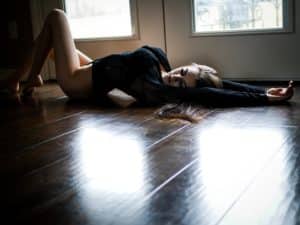
*WARNING: Muriatic acid can expose you to a chemical that is known to the State of California to cause cancer and birth defects or other reproductive harm. For more information go to www.P65Warnings.ca.gov.Related:
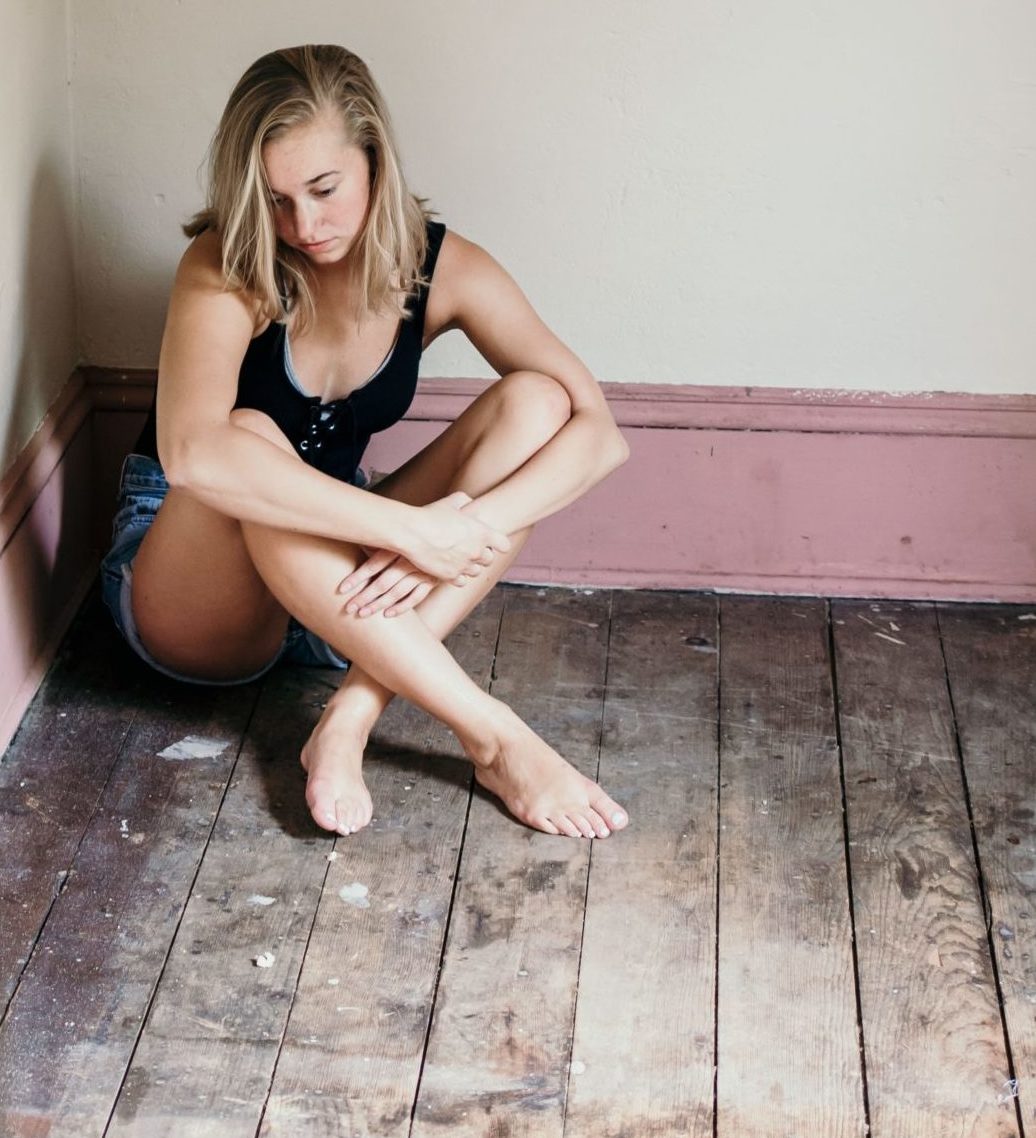
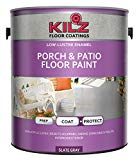
Great read
Fantastic post
We are in the middle of remodeling a 100+ home. The kitchen has been stripped of all past laminates, tiles, etc. all the way to the original wood floor. It is a 17×15′ room and we likely removed 3,000 small tacks. Other than some old water pipe holes and the thousands of tacks holes, the floor is in decent shape.
The same floor is on anenclosed porch. We used a the toughest latex we could find. However, pet stains, regular use dirt, etc. continue to darken the wood grains so the floor continues to look dirty and stained. Cleaning it does little to remove the dirtiness.
This brings me to my main question. We don’t want to have history repeat. We desire a kitchen floor with no wood grain indentions, cleans easily, and has a smooth, clean sheen, free of any splinters, etc. At present, we’ve used kilz as a base coat, plan to sand it so that residue gathers inthe small nails holes and cracks, then paint. We are at the point of choosing paint. My thoughts are a strong paint that includes a polyuethane, or one that will allow a polyuethane top coat to handle any spills, pet issues, etc., and to give us a smooth top coat.
My concern is that we’ll never get all the wood-grain roughness out and it’ll continue to need regular eblow grease to keep it clean and shiny. Any recommendations would be appreciated.
Thanks !
Hi. Careful here.
Wood floors have a 3-D texture and to smooth it will be hard. It’s not ever going to look like tile or linoleum etc unless you do a lot of coats of heavy floor coatings.
First, think tile but if you are set on paint, ok.
On the stains: I could not tell if they are bleeding thru or you mean that spills darken it. If bleeding tru, then you need a stain blocking primer then more paint. Not too bad. See this site about stain blocking primers. If pet pee is the problem, get a new pet!
But a good floor paint should not stain like that. Go Ben moore or Sherwin W.
On your plan here:
“so that residue gathers inthe small nails holes and cracks, ”
Woooooaa partner. Don’t do that. Fill those holes with floor crack filler, not dust. Clean them out first very well. You’ll have to fix it if you fill with dust.
Then
“polyurethane top coat”
I don’t like having clear on paint. You then have bonding issues and for next time you paint you have to put something on the clear coat for bonding…. on and on.
Just pick a good floor paint…my opinion. If you do top coat, get the best and check that it bonds with your underlying paint.
Filling thousands of holes! What a pro you are! Good job. That kind of detail gives you pride in your home.
Best of luck!
b
Hi, Brad,
Thanks for the great article on floor paints. I am at the launch point for a kitchen floor (plywood) that is to be painted and stenciled. The plywood is well-prepped, sanded, patched, and I will use BIN after final cleaning and before painting base coat At present, Ben Moore is telling me that Sure Step doesn’t come in white anymore (although I have not tried yet to order it from random dealers who may have some white left). They also say that S- Step comes only in a matte finish. That might be fine for stenciling over, as the stencil paint would surely grip, but matte would look pretty strange on a kitchen floor and possibly absorb stains, I would think. Any suggestions? BM won’t say whether I can even use a clear topcoat over it.
My other question concerns Tough Shield in the satin, if I have to use the desert sand because there’s no white. Will I be able to stencil over the Touch Shield with a satin SW latex paint and floor paint, and would the stenciling on satin on satin likely stick? If so, what would the time window be between applic of base coat and stenciling for successful adhesion?
Thanks so much for any advice!
Yes matte would look pretty strange on a kitchen floor. Although BM is the best along with Sherwin W., have a look at other makers who make white gloss. My only thought, sorry.
Yes you can go over any latex with another latex, in general. You’re right about a time window. You want to do it as soon as it is no longer tacky. Paint ‘cures’ after a while so do it while it’s still fresh for best results, but if you had to wait a week it’d be ok too.
Floor paint is tricky. It takes a beating every day. My top advice is to keep a small glass jar with a metal lid in the fridge for frequent touchups at least annually. Adhesion will be fine. Remember tho, it will not last forever. But will be fine until you get that tile in!!
b
Thanks for the info, especially the tip on putting little quantities of paint in the refrigerator (I am assuming that won’t work for oil paint leftovers). A SW employee told me this afternoon that I could use a satin bottom coat (even the Armor -Trex latex industrial paint, perhaps comparable to the INSL-X Tough Shield) and after stenciling scuff it lightly with 400 sandpaper or light steel wool — just enough to allow grip . . for a clear coat or 2 or 3 or 5. I’m looking forward to that working as a sealer!
Brad so helpful thanks for the post. Quick question…. Any ways to make the painted outdoor floors in breezeway have some traction so they are not slippery when wet?
Yes there is the description on this page.
Brad
I’m a DIY woman, if I use epoxy
rust oleum for wooden floors and let’s say 5 years from now, I want a different color of the same brand, will u have to remove that or can I paint over it?
Hi. Good question. From my reading, yes you can sand, clean well and re-do. The key is prep. Sand every square mm. Clean several times, get it totally dry and then repaint. Removing it would be a nightmare.
Good luck,
b
I have a very old house took all the carpets up hardwood floors underneath but a did sanding. Wanted suggestions on paintings the floor don’t have the money to have the floor redone professionally
It is really all covered in my post above. Sand clean prime paint.
Let me know if you have a specific question.
b
Hi!
I just bought a house that has engineered hardwood floors in the bedrooms. At someone painted them. I would like to give them a fresh coat of paint but not sure what to do first and hoping you can advise me.
Do I do a light sanding first?
Do I use primer? If so what kind?
Do I use oil base or latex paint? What kind?
The overall look I would like to achieve is high gloss and super white for a contemporary look. I even saw online where a designer use Armorseal Rexthane I in a dining room and it looks amazing! But I’m a little scared that it could be hazardous in my home?
Thank you in advance for your advice.
Well, those click floors should never have been 0painted, but since we’re here, yes prep is key. Scrape all loose, sand every square inch, use STIX primer or any high bonding primer, one coat then the floor paint of your choice. I read about Rexthane… never used it but other painters like it. Very smelly for a few weeks so keep windows open and children out for a few weeks until it’s cured (zero off-gassing).
Thank you so much for your reply! If I was not to use Rexthane due to it potentially being dangerous, do you have another suggestion for a semi gloss or high gloss bright white? Or do I just use a bright white and then to a polyurethane coat? Again thanks!
Yes, the paints above if you can find them in stock. I’m a big Ben Moore fan. Tough Shield is my go-to paint.
Do you know how the Benjamin Moore Floor & Patio enamel paint compares to the Tough Shield? They look very similar from the spec sheets and this seems to be all we can get in Canada at the moment.
Well the TS has more VOCs which only matters as it dries and cures… a few days. That may be why it’s less money, and it comes in more than 2 boring colors of the Patio. BM really pushes TS as it’s number one, so it’s my choice. I think it’s what you can get these days. Just be prepared to touch up the heavy traffic lane every couple of years. It’s what we do.
Good luck
b
Hi Brad,
Happy to have found your website!!
We attempted to stain and varnish our hardwood floors (sanded, cleaned, stained and poly’ed. The poly is uneven and now we are thinking of painting them instead. Do we have to sand again? Light or full sand to bare wood?
Yes unfortunately. There may be a slight chance that you can lightly sand and re-coat but since I don’t know your products, I can’t say.
If it has cured, it must all be de-glossed which means sanding or using a de-glosser: very nasty either way, but you are pros now!
Ask the two companies (poly and new paint) if they will bond or do you need a bonding primer. It may be just sanding is enough, but Stix is never a bad idea after sanding a floor. Be prepared to toouch up in the traffic lane every couple of years: sand and paint. Tricky but can be done.
We just un-earthed hardwood floors in on of our apartment units (I’m sure it is in all of them now that I’ve found these but one thing at a time). They have previously been painted so we will do a light sand. We were recommended to use Behr floor and deck stain? I feel like every place I’ve read says to use paint haven’t seen stain mentioned. Will this basically be the same concept or is paint going to go on better. One room is almost a black color which we wanted to try to get them more of a walnut color so I’m assuming we will have to prime? Since it’s a rental unit longevity is important but we always repaint between tenants so we expect wear to happen…..would appreciate suggestions
If you are lightly sanding paint, that means there will still be paint on the surface therefore stain is a no-go. Remove all the paint and stain, sure. That’s a professional job tho. Don’t try this at home!
Stain will not do what paint does. Stain is meant to penetrate and change color. Paint sits on top and protects.
Yes, just touch up between tenants…that’s exactly what I would do.
No paint is forever!
b
Wow am I glad I found you Brad! We’re about to paint a painted/varnished floor in an old house, and you answered a lot of my questions 😊 I want to use the best floor paint I can, but wish I could use a different color other than the 5 pre-mixed colors of INSL-X. Are there any other alternatives?
Yes. You can ask a paint store how much they can tint. For insulx you’d want to go to a Ben Moore shop. But there are other good paints. Sherwin Williams also is great. Kilz makes good paint, not great paint. The two above do much chemistry and research so…
Also, you can experiment with mixing white with colors,… but it’s tricky even for me. 50-50 white with anything hardly lightens the paint. It’s tinting that I never get right.
bottom line… ask a shop!
b
Brad-
I have an old house, built 1860’s. The floors are in bad shape. I can’t afford to pay someone to sanddown the floors and refinish them. I am planning on painting them, using stencils in some places like the entry.
I have purchased Rustoleum Home Floor Coating. What do you think of this product. I have seen the results in another old home and it turned out really nice.
Next question- what do I do to repair the wide cracks in between the old floorboards. I have seen many products recommended. Wood filler (didn’t really work well), bondo ( I haven’t tried this yet), caulk? I have even seen some type of small cord placed in between the wide cracks. Suggestions? I am a 67 year old widow trying to repair my home on limited income.
I plan on painting all the floors, one room at a time.
Well, floor paint is fine for some time, but obviously not as good as professional wood refinishing. But yes, that is a good product. Just be prepapred to touch up over the years in the traffic pattern.
Try floor leveler to fill cracks: dries very hard and very flat. Mix carefully.
Not so much bondo here, that’s for cars. One room at at time is smart, that’s the way to go.
Brad
We bought an old house a couple years ago that had been “updated” on the cheap. We decided to tear out the laminate and the ply underneath it. Under that was some really old school painted tar paper type stuff that must’ve been the predecessor to linoleum. Under that was the original 6” t&g floorboards. They were mostly coated with some type of hard finish. Old glue? Leveler? Paint? Hell I don’t know. They aren’t in fantastic shape so we don’t want to refinish but we do want to paint. So far I’ve used a drum sander and edger up to 100 grit, scraped any remaining loose stuff and plan to blend at 120 grit and stop. The wood is basically bare at this point. Now I’m a builder by trade but this is something I haven’t done before so any advice would be greatly appreciated. We’re going very dark. Sufficiently sanded? I assume I should prime. Tint primer? I’m not particular toward any specific brand of paint but I do get an excellent price at SW. Not opposed to others. Thanks.
Sounds like you are in great shape. If you tint a primer, let the pros do it: they know the limits… they know how far you can go and not harm the primer properties.
If you are going dark topcoat color, stains bleeding thru will not be that much of a problem, still I’d put down STIX by Ben Moore. It has some stain blocker properties.
Read about Stix here.
So primer and paint, 3 coats in all min. SW is great paint. Me, I’d go to a Ben Moore store and get Stix. It has somewhat stain-blocking ability, but it’s formulated for bonding: what you need on a floor like this. If you are concerned stains will bleed out of wood over the years, go over the Stix with a good SW stain-blocking primer. Then 2 coats finish paint.
I’m curious about your thoughts on the following. When I bought my house the previous owners had put down laminate everywhere but a section of carpet in the living room. Over time it became apparent there was a pet odor situation coming up from a large section of the carpet. I can’t deal with it anymore and my allergies don’t like the carpet plus I have two large dogs and three cats – the carpet has to go. Unfortunately I don’t have the funds to replace the flooring (hate the cheap laminate they installed but I can deal) so I have decided to pull the carpet, etc and paint the concrete (I’m on a slab with no subfloor). It’s not forever, it’s a temporary (18-24mos MAX) situation. I planned on cleaning and priming with odor stopping primer, but what paint (that I can choose the color of – like SW or BM) type is best for the situation? And how long before I can put my furniture back in place (I can apply felt pads or the like if necessary) and/or place the large rug on down? Thanks so much for your time.
Very simple. Just use any floor paint after your prmer. Since it is for only a couple of years, it will take the beating. You don’t have to spend a great deal here, grind the cement, acid wash blah blah. Just clean and prime and paint as you said. Pray all your paint jobs are so straightforward in the future! Yes, furniture can stick. I use wax paper, but anything could stick. If it does, just pull it up and touch up the spots.
I’d wait as long as the maker’s instructions say, then a little more if it’s cold where you are. Here? I’d wait 10 years!
Hi Brad
I have old wood subfloors that I previously painted with marine oil-based enamel years back, I now want to repaint with latex paint: Ben Moore Porch and Patio paint.
After prep, clean, and sand, I was advised NOT to prime–what are your thoughts? I am skeptical because it will be oil under latex.
Please send me your recommendation. Thanks!!
I would use STIX primer from ben more. Whoever told you that: what is their logic? Can you ask and tell me?
You need bonding primer, not stain blocking, but some have both. Stix is the best. You’ll see when you try to get it off your hands.
Then you are all set to go with your latex.
Good luck
Let me know if you hear anything.
b
I need to repaint a floor that was painted decades ago with oil based products. Can you give me the steps I need to take? It was originally plywood. I really don’t want to use an oil based product. It is a lofted spare bedroom. Do I need to sand it to give it tooth? Should I use a bonding primer and what type do you recommend? Best paint for an interior room floor and do you recommend a specific top coat?
If you are 100% sure it’s oil, ok, but read this to know how to test. Read it here.
To put water-based paints over oil you must degloss, or create a surface your primer can bond to. Yes you must use a great bonding primer. Deglosser is on that same page I linked.
Then Stix by Ben Moore (insl-x)
Then your floor paint.
Key is sanding or deglosser.
Brad
what is your experience with using these products on ceramic tile walls and floor? I have used Homax tough tile, the roll on version to paint a tub one time, and it was like painting a bathtub with nail polish no fun! I was doing some research and some say that Benjamin moore porch and patio in conjunction with insl-x primer works good, as opposed to a 2 part epoxy what’s your thoughts? and i learned with the tub its all about the prep when it come to this type of painting. any help would be great. thanks chris
I’ve painted a couple of tubs with the 2K epoxy. Tub paint writes checks it’s bonding can’t cash.
Painting tile is something I’d only ever do if I knew I was tearing out the tile in a year. Even the best floor/tile paint…whatever paint… will not last on a tile floor.
If they ever invent it, I’ll be shocked. It just cannot bond to the ceramic or whatever stone, even if sanded and prepped perfectly.
Best to rip the tile out if it’s cracked and put in some indestruct-o floor.
If you decide to go ahead, sand baby sand. Bring that ceramic down to the clay and use a great bonding primer. Then clean with alcohol a couple of times.
Then you might get some years out of it and if you are willing to touch up annually after that, ok. Still… it’s more effort than ripping it all out. I can’t see your space, but that’s my story.
Good luck!
Hello,
I recently had mild water damage and pulled up the laminate and osb under it. Below that was old tongue and groove subfloor that was mildly wet but had mold that I cleaned up and treated. I then primed with a mold primer and am planning to paint before putting down new plywood and vinyl plank flooring. What paint woyld you suggest for the primed floor and how long should I wait to put down the new plywood on top of it? Thanks for any advise.
Hi. If I understand what you have, I’d not apply any more paint. I think the primer, assuming it’s a primer-sealer, is ample. I’m not sure that I would have even done that as it’s not needed to make a bond with paint…you’re putting plywood on top of this primed wood right?
So it’s good that you did, it cannot hurt, but I’d just go ahead and start flooring.
Having said all that, I may not fully understand. Best bet is to have a pro floor company come look… I often send photos and ask questions to the makers of the products I want to use.
They are usually very happy to help.
I hope I helped.
brad
Many thanks. I just used the primer as an added precaution.
New (interior) pine v groove floor on exterior porches (not my choice!), and treated with Wood Classic wood preservative. There are some deeper knots and cracks I’d like to fill before painting. Is there a product you recommend for filling those? I’ll use the BIN shellac base primer to spot prime as you rec. What do you recommend for the whole floor as a primer since it’s “new” wood? Do I need to sand it if its not been painted or stained before? Since it is a high traffic area with steps, do you rec the Insl-X Tough Shield or Sure Step? It does get wet and we have snow and ice all Winter. The old flooring paint was sometimes scraped due to shoveling so it needs to be tough and slip resistant.
First, use BIN on all of it. You cannot be sure of the bonding in this case and you need the best. Pay the man.
Yes sand off the rough bits and open all the grain for the primer. Just scratch it is enough.
I like Sure Step… I’d add the silica. Read above how to do it. I just did some last week!
Just be resolved to touch up every spring or every other spring. It’s what we do.
Did I cover it all? Good luck!
b
Follow-up:
) I bought exterior filler for the deeper knots so they aren’t always full of dirt. Should I prime with BIN first or fill first?
2) And to clarify, you suggest I use SureStep on the whole porch rather than ToughShield? Its a flat finish, so will it be hard to clean? I tried to find a comparison between the 2 products, unsuccessfully. Other than the different sheen, SureStep must be thicker (like Behr antislip porch paint?) because the sq foot coverage is much lower than ToughShield?
3) So SureStep does not have something like silica already in it? (The Behr porch product does, very rough finish) Sprinkle silica and then roll over? Or mix into paint?
No need to prime before filling, only after.
You should use the paint you feel best about. Yes SureStep can fill cracks. It’s best for outside, but it’s up to you.
Yes S.Step does, but I’d still add silica to be safe esp on stairs. Read above how to broadcast. I wrote that you do not mix with paint.
“B-I-N Shellac-Base Primer is not recommended for whole surface exterior application or for application to floors, decks, or any surface subject to immersion or prolonged contact with water. ”
I saw this under the “Limitations” heading on the back of the can, 5 minutes AFTER I completed priming my shed’s floor with it. 🤦🏼♂️
Well I immediately think of 2 things. First, they have to say things to protect themselves. Almost no paint should be always wet, except swimming pool paint etc. If your floor is always wet, yes it could be a problem. If so, you’ll need to strip it some year, but live with it for now. I doubt it’s a problem if it dries out. It’s for exteriors after all. So no need to worry, but of course I cannot see the situation. Best of luck,
B
Hey Brad,
Great article…painting a new 12×10 shed floor. *yes, my wife and daughter claimed my new shed. Should I prime or just go for it and count on 2 coats since I have to buy a whole gallon anyways? Leaning towards your favorite.
If it has been painted, yes. If it is plywood or some unpainted surface, you must prime.
I can’t recommend one since I don’t know what the material is.
If you write back I’ll try
B
Hey thanks… it is wood and it is not primed. Thinking prime first then get at it.
Yes, a good ‘bonding’ primer. It will cost but it will be worth it.
Very clean and dry before you start.
b
Hi. I saw your comments about never painting vinyl but I am looking for a quick and easy finish for an art room floor. I removed the carpet and underneath I found 8×8 glue down tiles.
They have some paint and polyurethane stains that I am going to try to sand off. I then wanted to apply wall decals of paint droplets all over the floor or make my own paint splatters and polyurethane over either option. It is for a day care art room floor and I want it to look creative. Do you think it would last for a year or two?
It will last except where you walk on it a lot. If you put a clear coat of some sort over that…well nah. Second though… it won’t stick.
Just be prepared to fix it up when it gets bad.
B
We built a new house and the wood floor stair steps look horrible. We are thinking about painting them white and using Sure Step. Do the wood steps need a sanding first? A primer? I am desperate.
Hi. When you say wood floor, can I assume they have never been treated? That seems unlikely. YOu must mean varnished wood?
In either case, being a painter I’ll tell you the inside story: don’t paint it!
Paint needs re-coating in years to come. But if you want really, yes, sand it down to the wood and clean it very well, then use the best primer and floor paint you can afford. If you cannot remove some of whatever is on it now, paint, varnish, whatever… sand what you cannot remove very, very well with about 120 grit. The scratches provide ‘bite’, bonding.
What I would do? Glad you asked.
I’d strip any varnish off, and re-varnish, urethane whatever you want to call it. Some clear goop for floors. Wood is so beautiful… shame to paint it! Depends on the wood of course!
Good luck.
Hi Brad-
Thank you so much for this info. I’m wondering if there is any paint out there that you’d recommend for wood floors where there is a greater color selection?
That’s a problem with floor paint, they don’t make many because most folks just want the same old thing.
Go to a paint store and tell them what you want and ask if they can alter from, for example white to yellow or whatever you want.
Probably not because too much pigment changes the protection and toughness of a paint.
Sorry I can’t be of more help.
B